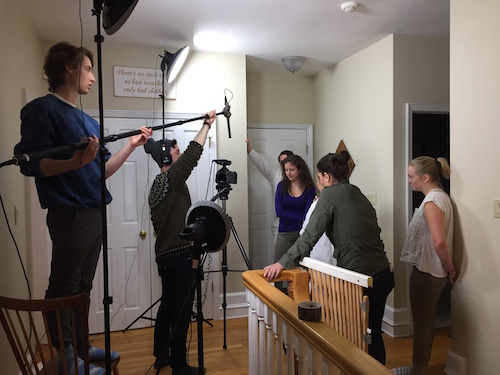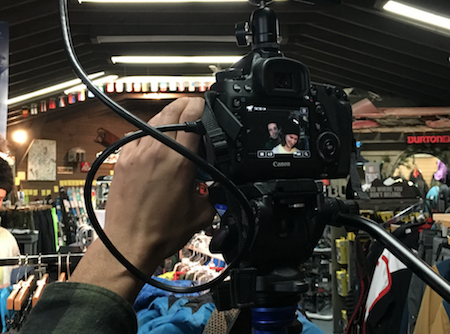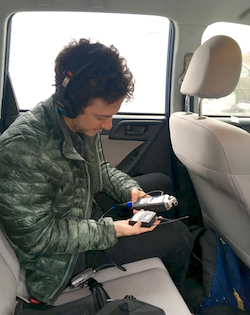New Course: Story to Screen

On the set of Heaven Only Knows. (Photo by Eli Ruben)
A new DS course this semester, DS 302 Story to Screen, was co-designed by Professors Nicole Coady and Vickie Riley, drawing on their respective talents in screenwriting and cinematography. For the past 15 weeks, the interdisciplinary course brought together student writer/directors, cinematographers and sound designers with the shared goal of creating an original short film. Though the course maintained a strong focus on fact-based research, it also given students the chance to explore the realm of narrative storytelling in a way that’s never before been offered at Skidmore.
The 12 students enrolled in DS 302 came from a diverse range of artistic backgrounds and worked to strengthen the individual skills they brought to the classroom setting and their respective films. When

Shooting "Operation Suckerpunch" - photo, Sam Grant
asked to describe the class in her own words, Riley pointed out that "We want students to take the skills they’ve learned in other classes and test their ability in a collaborative, real-world situation.” The class, though taught during one shared time block, was subdivided into the three categories of crew roles so as to approach each discipline thoroughly and attentively. “Each student ‘owns’ their part of the film. It’s up to them how to direct the actors, or how to approach sound or cinematography to further the story," she adds. While cinematographers and sound designers covered topics like camera angles, foley recording and equipment handling, writer/directors discussed the basics of screenplay writing, festival circuits and casting calls.
Though the material covered in class differed among the three groups, all of the students were responsible for producing an in-depth research paper on a topic of their choice, so as to ground their creative feats in fact. The chosen subjects of the papers ranged from the effects of PCP on the brain (a topic broached in one of the films) to the visual identifiers of 1940s film noir, and offered students the chance to explore a topic or style embraced by their film that they were excited to learn more about. “We’re trying to use evidence-based storytelling as we tell our narratives,” Coady explains. “All of these unique projects are rooted in research; that’s how we connect to the broader goal of the MDOCS program.”

Caleb Weiss (sound)
(Photo by Anna Parsons)
Even students not enrolled in the course have voiced their enthusiasm and support for it and are eager to see the addition of narrative-based film classes into the existing documentary program. “We have outstanding musicians/sound designers, cinematographers, screenwriters and actors on campus,” Riley notes. “We had the interest, talent and helpful advice from a number of faculty. Jordana Dym, in particular, was crucial in providing some of the answers we needed and it can’t go unsaid that the support we got for gear was incredibly generous.”
Dym is delighted with this year's projects and looking forward to next year's class, which promises to introduce documentary storytellers to crew-based work. "In 2014, Larry Hott argued that documentarians (whose reenactments have much in common with narrative filmmaking) have 95% of a narrative filmmaker's toolkit," she observes. "I look forward to findout out how the two kinds of filmmakers grow from each other."
Already in the process of redesigning and tweaking the class for next spring, Coady mentioned that “there’s definitely been a learning curve this semester, because it’s the first time we’re offering the course.” Students and faculty alike are looking forward to seeing how the course grows in coming years, particularly following the excitement following the recent two-night MDOCS Student Showcase, the event at which all four short films premiered to their very first outside audiences. Shot both on and off Skidmore campus, projects featured the work of both student and professional actors, many of whom were in attendance to see the culmination of their work.
For several members of the class, this was their first taste of producing a film from its pre-production phase (script writing, researching, casting, planning, etc.) into post-production (editing, sound design, color correction, etc.). This hands-on experience gave students the chance to wear multiple hats, some taking on roles they were less familiar with, such as directing, editing and makeup design. DS 302 is a chance to broaden your cinematic horizons and step outside of your academic comfort zone. "Film is the quintessential interdisciplinary medium,” Riley explains. “When you get people together who are excellent at what they do, something great can happen. That’s the opportunity Nicole Coady and I wanted to provide with this class.”
Final films/class credits included:
Love in Idleness: Written/cirected by Bianca Thompson; cinematography by Jennifer Davies; sound design by Connor Crawford
Operation Suckerpunch: Written/directed by Sam Grant; cinematography by Dante Haughton; sound design by Graham Gilmore
Loved Ones: Written/directed by Alix Marello; cinematography by Wilson Espinal; sound design by Jack Mullin
Heaven Only Knows: Written/directed by Anna Parsons; cinematography by Eli Ruben; sound design by Caleb Weiss
